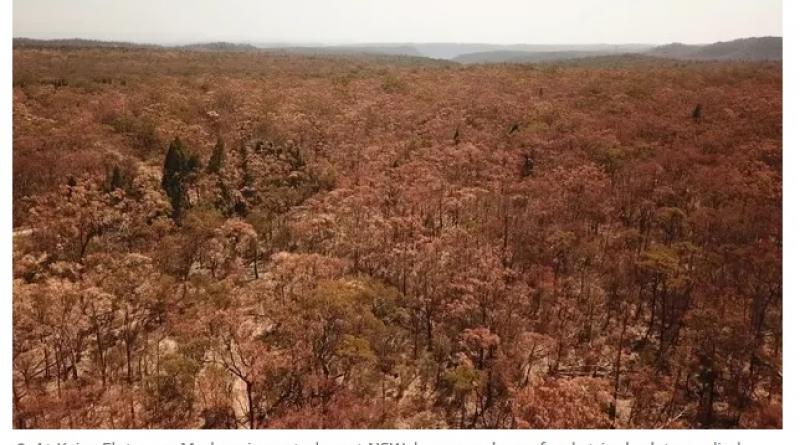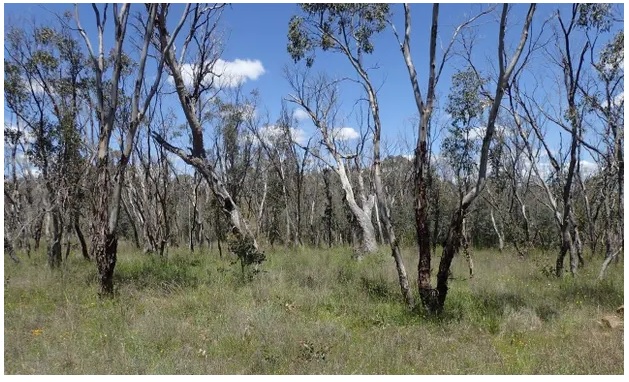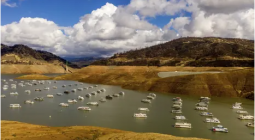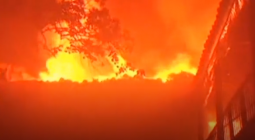‘Just sitting there dead’: study finds mass tree losses in NSW after severe drought

Even species ‘superbly adapted’ for Australia’s harsh conditions suffered, with up to 60% of trees dying in some areas
Secret document urges native logging halt in NSW regions hit hard by black summer bushfires
The drought and heatwaves that seared eastern Australia in the lead-up to the 2019-20 black summer bushfires killed as much as 60% of the trees in some areas that escaped the fires, according to new research.
While Australian species are typically hardened to extreme conditions, the record heat and dryness of 2019 pushed some common tree varieties beyond their thresholds, potentially threatening whole ecosystems if they don’t grow back.
Working off information about diebacks supplied to the citizen science website the Dead Tree Dectective, researchers at Western Sydney University’s Hawkesbury Institute for the Environment assessed the health of 18 tree species across 15 New South Wales forest and woodlands.
Measurements were taken during the drought and about eight to 10 months after good rains, finding trees deaths reached 60-70% in the worst affected areas. The sites examined ranged from the northern tablelands down to the southern highlands region of the state.
“There was some snow gums up around Armidale – which is the northern extent of their range – they were hit very badly,” said Brendan Choat, an associate professor at the university and a lead author of a paper to be submitted to the Frontiers in Plant Science journal.
“About 60% of them didn’t recover in any way.”
Red stringybark trees and brittle gums were among other species that suffered losses of up to 50% in the sites studied.

Choat said that visits after the rains can mask the extent of forest loss, with lots of grass returning and pioneer species coming back. “But a lot of the bigger trees amongst those [green] patches are just sitting there dead,” he said.
The study found “trees with a severely compromised canopy immediately after drought did not manage to recover even with prolonged favourable water availability”. The loss of leaf cover indicated a failure in trees’ internal hydraulic system that draws moisture from the roots to the canopy.
Researchers are debating whether younger or older trees fared worse. Choat said smaller trees, with less developed root systems, appeared more vulnerable as they were less able to tap into soil moisture and groundwater than larger ones.
Still, many trees aged 40 years or older also perished, underscoring the severity of conditions for plants that were “superbly adapted” for Australian conditions.
Some of the trees that survived the drought also struggled afterwards. With root loss, they were susceptible to being blown over, particularly if soils later became saturated.
The widespread loss of often common species could trigger the transformation of ecosystems from forests to woodlands, or woodlands to scrublands, Choat said.
But such trends were difficult to predict given the limited modelling on vegetation done in Australia compared with many northern hemisphere areas. Uncertainties also remain about how the climate will change with global heating.
“Even if you have very high rainfall years [and] you have more extreme droughts and more intense fire burning between those, that will not be enough to maintain some of those systems,” he said. “You’re more likely to get some big changes there.”

Philip Spark, an ecologist based in Tamworth in northern NSW, recently photographed large areas of dieback near his town and land between Bundarra and Uralla.
Areas affected include the endangered Blakely’s red gum and white box ecological communities. “There are whole hillsides of dead trees,” Spark said. “It certainly crossed a threshold.
“It’s definitely by far the worst I’ve seen [in terms of mass dieback] and I’ve been here since 1964.”
The potential change of tree species could have far-reaching effects because such shifts would alter the availability and seasonality of food resources for insects, birds and other species, Spark said.
“It remains to be seen if they’ll regenerate down the track.”





